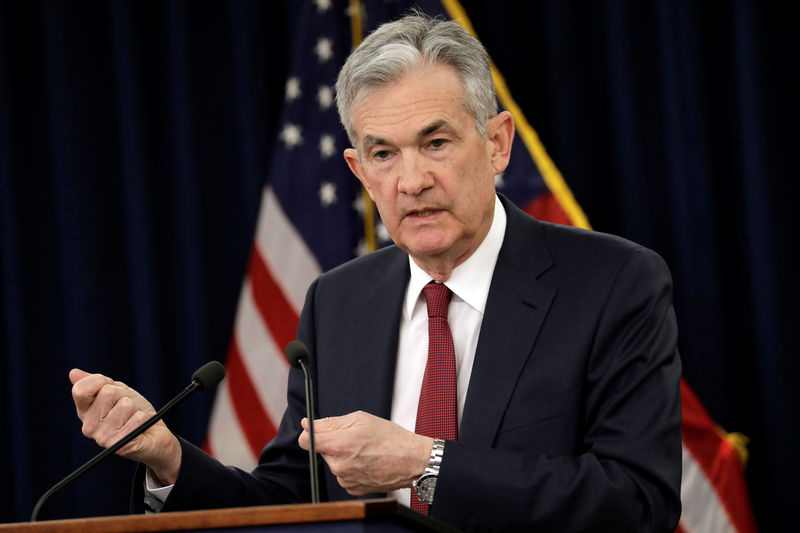 © Reuters. Federal Reserve Board Chairman Jerome Powell holds a news conference after a Federal Open Market Committee meeting in Washington
© Reuters. Federal Reserve Board Chairman Jerome Powell holds a news conference after a Federal Open Market Committee meeting in WashingtonBy Jason Lange and Ann Saphir
WASHINGTON/SAN FRANCISCO (Reuters) – Jerome Powell had a bumpy first year as Federal Reserve chairman when it came to talking policy, by turns spooking and comforting investors even as economic data offered increasingly mixed signals and President Donald Trump stepped up his attacks on the U.S. central bank.
And as 2018 closes out with a dramatic slump in stocks and a drop in bond yields, financial markets will need to brace for next year, when Powell is scheduled to make more unscripted public remarks than any Fed chief in history.
A lawyer and former investment banker whose long career in markets and government gave him the real-world perspective Trump sought in a Fed chair, Powell took office in February determined to improve the Fed’s communications with Congress and the public. He meets frequently with legislators, and speaks about policy in a style that is less economic textbook and more folksy than past Fed chiefs, who in recent decades have all been economists.
That style may have been part of Powell’s appeal to Trump, but it has arguably contributed to market volatility as investors hang on Powell’s every word for clarity on how much further the Fed may raise rates.
“I have people in my building who are just furious about this,” said Carl Tannenbaum, chief economist at Northern Trust (NASDAQ:), referencing Powell’s recent description of the Fed’s current situation as walking through a dark room.
Though the metaphor was meant to show Powell’s appreciation of the uncertainty the central bank faces and a reason for caution, Tannenbaum said it left investors in the lurch. “The problem is, the Fed can’t just sit there in the dark. The Fed has to make an effort to shed light on what’s going on.”
Powell has continued to advertise the Fed’s “uncertainty,” using the word four times at his Dec. 19 news conference following the Fed’s rate hike at its last policy meeting of the year.
But with Powell sending one set of messages in his remarks – that risks are mounting and rate hikes may need to go slower – while still producing Fed forecasts that show rates continuing to rise next year, “The message in here is a little bit sloppy,” said University of Oregon economics professor Tim Duy.
Crystal-clear guidance, meanwhile, has its own drawbacks.
At the December news conference following the Fed’s fourth rate hike of 2018, Powell said definitively that the Fed’s balance sheet downsizing was on “automatic pilot” and he did not anticipate any changes. Though the remarks were consistent with past Fed guidance, stocks sank on disappointment that he did not indicate more flexibility.
A couple days later, New York Fed President John Williams (NYSE:), a close ally of Powell and a permanent voter on the Fed’s policy-setting committee, conveyed a softer approach. Stocks rose.
All Fed chairs have stumbled, and roiled markets across the globe as a result. Ben Bernanke in 2013 sent world stocks plummeting when he suggested the Fed would slow its bond-buying stimulus. Alan Greenspan back in 1996 tried to deflate stocks by noting “irrational exuberance” in asset values, though the effect was short-lived.
But past Fed chairs have never operated under the current level of open scrutiny from the White House, with Trump’s own commentary roiling markets as well.
Complicating matters further, weaker global growth may threaten what have been powerful gains in the U.S. job market and strong domestic growth. Add to that a trade war with China and a shutdown of parts of America’s federal government over a budget impasse, and the result is a potent blend of uncertainties that have markets betting the Fed will not raise rates even once next year.
It is against this background that starting in January Powell will hold a news conference after every Fed meeting to provide more clarity about Fed actions and thinking, as he explained when he announced the change in June. The change will mean that Powell will hold eight news conferences in 2019, up from the current practice of four per year.
But the change also increases the odds of a stray market-rankling remark.
It might be a good time to say even more forcefully that the Fed does not have all the answers, said former Fed Vice Chair Alice Rivlin.
“That’s always difficult,” Rivlin said, recounting Greenspan’s reaction when she used the word “guess” in a speech. “(He) said, don’t use the word ‘guess’ because it sounds like we don’t know what we’re doing. And I thought well, okay — but we don’t.”
Source: Investing.com





























